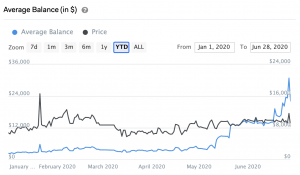Decentralized finance (DeFi) protocols have taken on increased significance in recent weeks. The total value locked in these applications crossed $1 billion, while the emergence of protocol governance tokens like Compound’s COMP brought in massive profit for investors.
Amid the growth, the number of Bitcoin used as collateral for DeFi wrapped tokens such as WBTC has also seen a massive influx. For context, the number BTC on Ethereum has greatly surpassed the number of BTC on off-chain scalability solution, Lightning Network.
However, a new study by our data partner, IntoTheBlock, attributes the growing number of Bitcoin on Ethereum, especially WBTC, to the emergence of new kinds of institutions. These organizations reportedly came to the fore after the roll-out of incentives to liquidity providers on DeFi protocols like Ren, Curve, and Synthetix.
Through a process known as yield farming, these new organizations lend and borrow crypto assets intending to realize the best returns from a combination of new reward tokens like COMP, or the interest rates payable on the loans they provide.
Citing on-chain data for the average balance of WBTC holders, IntoTheBlock insights show that it is very unlikely that retail investors are behind the recent influx of BTC in Ethereum. From an average balance of $2,350 at the start of the year, the balance grew to $30,800 in late June. It then dropped to around $22,000 in the last few days.

Over a certain six-day period following the release of yield farming opportunities, WBTC large transaction volumes reportedly went from near zero to over $300 million. The study concluded that the spike in large transaction volumes and average balance suggests that wrapped bitcoin (WBTC) has attracted “these new institutions and large players, boosting its network activity and market capitalization.”
If the DeFi space continues to sustain the recent growth (current valuation is $1.8 billion), there is little doubt that it could provide an outlet for the crypto industry to birth a unique kind of institutional participation. Such growth, also, may especially be vital with mainstream institutional involvement in the general crypto industry still at trickle levels.










